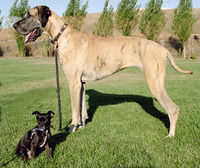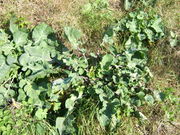Common descent
| Part of the Biology series on |
| Evolution |
| Mechanisms and processes |
|---|
|
Adaptation |
| Research and history |
|
Introduction |
| Evolutionary biology fields |
|
Cladistics |
| Biology portal · |
In evolutionary biology, a group of organisms have common descent if they have a common ancestor. "There is strong quantitative support, by a formal test"[1] for the theory that all living organisms on Earth are descended from a common ancestor.[2]
Charles Darwin proposed the theory of universal common descent through an evolutionary process in On the Origin of Species, saying, "There is a grandeur in this view of life, with its several powers, having been originally breathed into a few forms or into one"[3]
The last universal ancestor (LUA) (or last universal common ancestor, LUCA), that is, the most recent common ancestor of all currently living organisms,[1] is believed to have appeared about 3.9 billion years ago.[4][5]
In The Ancestor's Tale, Richard Dawkins coined the word concestor, as a substitute for common ancestor or most recent common ancestor. This new word is very gradually entering scientific parlance.[6]
Contents |
History
In the 1740s, Pierre-Louis Moreau de Maupertuis made the first known suggestion in a series of essays that all organisms may have had a common ancestor, and that they had diverged through random variation and natural selection.[7][8] In Essai de Cosmologie, Maupertuis noted:
Could one not say that, in the fortuitous combinations of the productions of nature, as there must be some characterized by a certain relation of fitness which are able to subsist, it is not to be wondered at that this fitness is present in all the species that are currently in existence? Chance, one would say, produced an innumerable multitude of individuals; a small number found themselves constructed in such a manner that the parts of the animal were able to satisfy its needs; in another infinitely greater number, there was neither fitness nor order: all of these latter have perished. Animals lacking a mouth could not live; others lacking reproductive organs could not perpetuate themselves ... The species we see today are but the smallest part of what blind destiny has produced ...[9]
In 1790, Immanuel Kant wrote in Kritik der Urtheilskraft (Critique of Judgement) that the analogy of animal forms implies a common original type, and thus a common parent.[10]
In 1795, Charles Darwin's grandfather, Erasmus Darwin, asked:
[W]ould it be too bold to imagine, that in the great length of time, since the earth began to exist, perhaps millions of ages before the commencement of the history of mankind, would it be too bold to imagine, that all warm-blooded animals have arisen from one living filament, which the great First Cause endued with animality, with the power of acquiring new parts attended with new propensities, directed by irritations, sensations, volitions, and associations; and thus possessing the faculty of continuing to improve by its own inherent activity, and of delivering down those improvements by generation to its posterity, world without end?[11]
In 1859, Charles Darwin's The Origin of Species was published. The views about common descent expressed therein were that it was possible that there was only one progenitor for all life forms.
"Therefore I should infer from analogy that probably all the organic beings which have ever lived on this earth have descended from some one primordial form, into which life was first breathed." [3] (p 484)
Darwin's famous closing sentence describes the "grandeur in this view of life, with its several powers, having been originally breathed into a few forms or into one."[3] (p 490)
Evidence of universal common descent
Common biochemistry and genetic code
All known forms of life are based on the same fundamental biochemical organisation: genetic information encoded in DNA, transcribed into RNA, through the effect of protein- and RNA-enzymes, then translated into proteins by (highly similar) ribosomes, with ATP, NADH and others as energy sources, etc. Furthermore, the genetic code (the "translation table" according to which DNA information is translated into proteins) is nearly identical for all known lifeforms, from bacteria to humans. The universality of this code is generally regarded by biologists as definitive evidence in favor of the theory of universal common descent. Analysis of the small differences in the genetic code has also provided support for universal common descent.[12] A statistical comparison of various alternative hypotheses has shown that universal common ancestry is significantly more probable than models involving multiple origins.[13]
Selectively neutral similarities
Similarities which have no adaptive relevance cannot be explained by convergent evolution, and therefore they provide compelling support for the theory of universal common descent.
Such evidence has come from two areas: amino acid sequences and DNA sequences. Proteins with the same three-dimensional structure need not have identical amino acid sequences; any irrelevant similarity between the sequences is evidence for common descent. In certain cases, there are several codons (DNA triplets) that code for the same amino acid. Thus, if two species use the same codon at the same place to specify an amino acid that can be represented by more than one codon, that is evidence for a recent common ancestor.
Other similarities
The universality of many aspects of cellular life is often pointed to as supportive evidence to the more compelling evidence listed above. These similarities include the energy carrier adenosine triphosphate (ATP), and the fact that all amino acids found in proteins are left-handed. It is possible that these similarities resulted because of the laws of physics and chemistry, rather than universal common descent and therefore resulted in convergent evolution.
Phylogenetic trees
Another important piece of evidence is that it is possible to construct detailed phylogenetic trees (that is, "genealogic trees" of species) mapping out the proposed divisions and common ancestors of all living species. In 2010 an analysis of available genetic data, mapping them to phylogenetic trees, gave "firm quantitative support for the unity of life. ...there is now strong quantitative support, by a formal test[1], for the unity of life.[2]
Traditionally, these trees have been built using morphological methods, such as appearance, embryology, etc. Recently, it has been possible to construct these trees using molecular data, based on similarities and differences between genetic and protein sequences. All these methods produce essentially similar results, even though that most genetic variation has no influence over external morphology. That phylogenetic trees based on different types of information agree with each other is strong evidence of a real underlying common descent.[14]
Illustrations of common descent
Artificial selection
Artificial selection demonstrates the diversity that can exist among organisms that share a relatively recent common ancestor. In artificial selection, one species is bred selectively at each generation, allowing only those organisms that exhibit desired characteristics to reproduce. These characteristics become increasingly well-developed in successive generations. Artificial selection was successful long before science discovered the genetic basis.

Dog breeding
The diversity of domesticated dogs is an example of the power of artificial selection. All breeds share common ancestry, having descended from wolves. Humans selectively bred them to enhance specific characteristics, such as color and length or body size. This created a range of breeds that include the Chihuahua, Great Dane, Basset Hound, Pug, and Poodle. Wild wolves, which did not undergo artificial selection, are relatively uniform in comparison.
Wild cabbage

Early farmers cultivated many popular vegetables from the Brassica oleracea (wild cabbage) by artificially selecting for certain attributes. Common vegetables such as cabbage, kale, broccoli, cauliflower, kohlrabi and Brussels sprouts are all descendants of the wild cabbage plant.[15] Brussels sprouts were created by artificially selecting for large bud size. Broccoli was bred by selecting for large flower stalks. Cabbage was created by selecting for short petioles. Kale was bred by selecting for large leaves.
Natural selection

Natural selection is the evolutionary process by which heritable traits that increase an individual's fitness become more common, and heritable traits that decrease an individual's fitness become less common.
Darwin's finches
During Charles Darwin's studies on the Galápagos Islands, Darwin observed 13 species of finches that are closely related and differ most markedly in the shape of their beaks. The beak of each species is suited to the food available in its particular environment, suggesting that beak shapes evolved by natural selection. Large beaks were found on the islands where the primary source of food for the finches is nuts and therefore the large beaks allowed the birds to be better equipped for opening the nuts and staying well nourished. Slender beaks were found on the finches which found insects to be the best source of food on the island they inhabited; their slender beaks allowed the birds to be better equipped for pulling out the insects from their tiny hiding places. The finch is also found on the main land and it is thought that they migrated to the islands and began adapting to their environment through natural selection.
See also
References
- ↑ 1.0 1.1 1.2 Theobald, D.L., Nature 465, 219-222, (2010)
- ↑ 2.0 2.1 Steel, M. & Penny, D., Nature 465,168 (2010)
- ↑ 3.0 3.1 3.2 Darwin, C., "The Origin of Species by Means of Natural Selection, or the Preservation of Favoured Races in the Struggle For Life", London, John Murrary, (1859) p. 490
- ↑ Doolittle, W. Ford (February, 2000). Uprooting the tree of life. Scientific American 282 (6): 90–95.
- ↑ Nicolas Glansdorff, Ying Xu & Bernard Labedan: The Last Universal Common Ancestor : emergence, constitution and genetic legacy of an elusive forerunner. Biology Direct 2008, 3:29.
- ↑ Singham, Mano (October 13, 2006). "Looking for Deep Ancestors". Machines Like Us. http://machineslikeus.com/articles/LookingForDeep.html. Retrieved November 19, 2009.
- ↑ J. S. Bromley, The new Cambridge modern history: The rise of Great Britain and Russia, 1688-1715/25, CUP Archive, 1970, ISBN 9780521075244, pgs. 62-63.
- ↑ Geoffrey Russell Richards Treasure, The making of modern Europe, 1648-1780, Taylor & Francis, 1985, ISBN 9780416723700, pg. 142
- ↑ C. Leon Harris, Evolution, genesis and revelations, with readings from Empedocles to Wilson, SUNY Press, 1981, ISBN 9780873954877, pg. 107
- ↑ Immanuel Kant and Werner S. Pluhar, Critique of Judgment, Hackett Publishing, 1987, ISBN 9780872200258, p. 304: "Despite all the variety among these forms, they seem to have been produced according to a common archetype, and this analogy among them reinforces our suspicion that they are actually akin, produced by a common original mother."
- ↑ Darwin, Erasmus (1818) [1795]. "Generation". Zoonomia; or the Laws of Organic Life. 1 (4th American ed.). Philadelphia: Edward Earle. p. 397 [§ 39.4.8]. http://books.google.com/books?id=XRUaAAAAMAAJ&printsec=frontcover&source=gbs_navlinks_s#v=onepage&q=&f=false. Retrieved November 20, 2009.
- ↑ Knight, Robin, et al. (January 2001). "Rewiring the Keyboard: Evolvability of the Genetic Code". Nature Reviews Genetics 2 (1): 49–58. doi:10.1038/35047500. PMID 11253070.
- ↑ Theobald, Douglas L. (13 May 2010). Nature 465 (7295): 219–222. doi:10.1038/nature09014.
- ↑ Theobald, Douglas (2004). "Prediction 1.3: Consilience of Independent Phylogenies". 29+ Evidences for Macroevolution. TalkOrigins Foundation. http://www.talkorigins.org/faqs/comdesc/section1.html#independent_convergence. Retrieved November 20, 2009.
- ↑ Raven, Peter H., et al. (2005). Biology of Plants (7th rev. ed.). New York: W.H. Freeman. ISBN 0716762846. OCLC 183148564. "[These vegetables were] all produced from a single species of plant (Brassica oleraca), a member of the mustard family."
External links
- 29+ Evidences for Macroevolution: the Scientific Case for Common Descent. From the TalkOrigins Archive
- The Tree of Life Web Project
|
|||||